Eberhard IV of Württemberg (23 August 1388, Stuttgart – 2 July 1419, Waiblingen) was the ruling Count of Württemberg from 1417 until his death. He was elder son of Count Eberhard III and Antonia Visconti. On 13 November 1397 he became engaged to Henriette of Mömpelgard. Henriette was the oldest daughter and main heiress of Henry of Mömpelgard, who died in 1396 one year before his father, Count Stephan of Mömpelgard. Their marriage, which occurred in 1407 at the latest, caused the county of Mömpelgard to become part of Württemberg. Eberhard IV also had a child with Agnes von Dagersheim.

Henriette (1387 – 14 February 1444) was the daughter of Henry of Orbe (died 1396), and the heiress of her grandfather, Stephen, Count of Montbéliard.[1] Her great-grandfather was Henry I of Montbéliard. She married Eberhard IV, Count of Württemberg and governed the city of Montbéliard together with her husband.
Henry XVI of Bavaria (1386 – 30 July 1450, Landshut), (German: Heinrich der Reiche, Herzog von Bayern-Landshut), since 1393 Duke of Bavaria-Landshut. He was a son of duke Frederick and his wife Maddalena Visconti, a daughter of Bernabò Visconti. Duke Henry XVI was the first of the three famous rich dukes, who reigned Bavaria-Landshut in the 15th century. Their residence was Trausnitz Castle in Landshut, a fortification which attained enormous dimensions. Having inherited not only the black hair but also the despotic temperament of the Visconti, Henry oppressed very cruelly uprisings of the citizenry of Landshut in 1410 and fought successfully against his cousin Louis VII the Bearded, the duke of Bavaria-Ingolstadt. He united Louis’ enemies in theParakeet Society of 1414 and the League of Constance of 1415.

Henry the Elder of Münsterberg (also called Henry I of Münsterberg, Henry I of Oels; Czech: Jindřich starší z Minstrberka orJindřich starší z Poděbrad; German: Heinrich der Ältere von Münsterberg or Heinrich I. von Oels; 1448 – 1498, Kłodzko) was anImperial Count and Count of Kladsko. He was also Duke of Silesian duchies Münsterberg and Oels and 1465–1472 Duke of Opava. At times, he served as the Landeshauptmann and governor of Bohemia.
Henry was descended from the Poděbrady branch of the Kunštát family. His parents were King George of Poděbrady of Bohemia and Kunigunde of Sternberg. In order of siblings Henry was the third son after the older brothers Boček and Victor.

Ursula of Brandenburg (25 September 1450 – 25 November 1508, Breslau) was a princess of Brandenburg by birth and by marriage Duchess of Münsterberg and Oels and Countess of Glatz.
Ursula was the eldest child of the Elector Albrecht Achilles of Brandenburg (1414–1486) from his first marriage to Margarete of Baden (1431–1457).
John II (German: Johann II.; 2 August 1455 – 9 January 1499) was Elector of Brandenburg from 1486 until his death, the fourth of the House of Hohenzollern. After his death he received the cognomen Cicero, after the Roman orator Cicero, but the elector's eloquence and interest in the arts is doubtful.[1]
John Cicero was the eldest son of Elector Albert III Achilles of Brandenburg with his first wife Margaret of Baden.
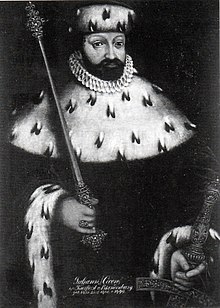
Margaret of Saxony (1449 – 13 July 1501) was a German noblewoman, Electress of Brandenburg by marriage.
She was the daughter of William III, Duke of Luxemburg, and Anne, Duchess of Luxembourg.

John, also known as Hans; né Johannes[1] (2 February 1455 – 20 February 1513) was King of Denmark (1481–1513), Norway(1483–1513) and as John II (Swedish: Johan II) of Sweden (1497–1501) in the Kalmar Union, and also Duke of Schleswig andHolstein. The three most important political goals of King John were the restoration of the Kalmar Union, reduction of the dominance of the Hanseatic League, and the building of a strong Danish royal power. He was born at Aalborghus, in Aalborg, the son of Christian I of Denmark and Dorothea of Brandenburg, daughter of Margrave John of Brandenburg. In 1478, he married Christina of Saxony, granddaughter of Frederick the Gentle of Saxony. This produced the following offspring: Christian II, Francis, Knud, and Elisabeth, who later married as princess of Brandenburg. From about 1496 until 1512, he had a relationship with Edele Jernskjæg

Christina of Saxony (b. Torgau, 25 December 1461 – d. Odense, 8 December 1521), was a Saxon princess who became Queen consort of Denmark, Norway, and Sweden. She was born a granddaughter of Frederick the Gentle of Saxony, and daughter ofErnest, Elector of Saxony and Elisabeth of Bavaria. She was the grandmother of Christina of Denmark through her son Christian II.

John I, Duke of Lüben (1425 – after 21 November 1453), was a ruler of Lüben (Lubin) during 1441-1446 with his brother, as co-rulers, Haynau (Chojnów) since 1452, Brieg (Brzeg) and Goldberg (Złotoryja) during 1449-1450 with his brother, as co-rulers.
He was the eldest son of Louis III, Duke of Ohlau-Lüben-Haynau, by his wife Margaret, daughter of Duke Bolko IV of Oppeln.
Joanna of Rosenthal (c. 1430 – 12 November 1475) was Queen consort of Bohemia as the second wife of George of Poděbrady.
She was a daughter of John of Rožmitál and his wife Ludmilla of Strakonicz.[

Albert III (German: Albrecht III.) (9 November 1414 – 11 March 1486), often known simply as Albert Achilles (Albrecht Achilles), was a Prince-elector of the Margraviate of Brandenburg. He received the nickname Achilles because of his knightly qualities. He also ruled the Principality of Ansbach.
Albert was born in Tangermünde as the third son of Elector Frederick I and his wife, Elisabeth of Bavaria-Landshut. After passing some time at the court of Emperor Sigismund, Albert took part in the war against the Hussites, and afterwards distinguished himself whilst assisting the German king, Albert II, against Poland.[1]
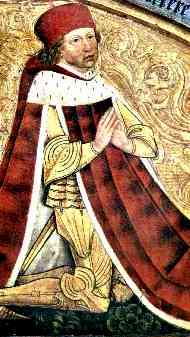
Margaret of Baden (1431 – 24 October 1457) was a Margravine of Baden by birth and by marriage Margravine of Brandenburg-Ansbach and Brandenburg-Kulmbach. She was the daughter of Jacob, Margrave of Baden-Baden, and his wife Catherine of Lorraine.
William III (30 April 1425 – 17 September 1482), called the Brave (in German Wilhelm der Tapfere), was landgrave of Thuringia(from 1445) and claimant duke of Luxemburg (from 1457). He is actually the second William to rule Thuringia, and in Luxembourg; he was the third Margrave of Meissen named William. He was a younger son of Frederick I the Warlike, elector of Saxony, and Catherine of Brunswick and Lunenburg. On 2 June 1446 he married Anne of Luxembourg, daughter of Albert II, King of Germany, Bohemia and Hungary and Elisabeth of Luxembourg. On behalf of his wife, he became Duke of Luxembourg from 1457 to 1469. They had two daughters, Margaret of Thuringia (1449–1501) and Catherine of Thuringia (1453 – 10 July 1534), who married DukeHenry II of Münsterberg.
Anne of Bohemia and Austria (12 April 1432 – 13 November 1462) was a Duchess of Luxembourg in her own right, and as consort, Landgravine of Thuringia and of Saxony.
She was the eldest daughter of Albert of Austria, the future Emperor-Elect and Elisabeth, queen of Bohemia, the sole descendant ofSigismund, Holy Roman Emperor.
Christian I (February 1426 – 21 May 1481) was a Scandinavian monarch under the Kalmar Union. He was King of Denmark (1448–1481), Norway (1450–1481) and Sweden (1457–1464). From 1460 to 1481, he was concurrently Duke of Schleswig and Count(from 1474: Duke) of Holstein. He was the first Danish monarch of the House of Oldenburg.
He was a son of Count Dietrich of Oldenburg and Hedwig of Holstein, a descendant of King Eric V of Denmark. In the power vacuum that arose following the childless death of King Christopher of Denmark, Sweden and Norway in 1448, Sweden elected Charles VIIIking with the intent to reestablish the union under a Swedish king. Charles was elected king of Norway in the following year, but thecounts of Holstein were more influential than the Swedes and the Norwegians together, and made the Danish Privy Council appoint Christian as king. His subsequent accessions to the thrones of Norway (in 1450) and Sweden (in 1457), restored the unity of the Kalmar Union for a short period. In 1460, following the childless death of his uncle, Duke Adolphus of Schleswig, Count of Holstein, Christian also became Duke of Schleswig and Count of Holstein.

Dorothea of Brandenburg (1430/1431 – 10 November 1495) was the wife of Christopher of Bavaria and Christian I of Denmark. She was Queen of Denmark (1445–1448 and 1449–1481), Norway (1445–1448 and 1450–1481), and Sweden (1447–1448 and 1457–1464) two times each. She also served as regent in Denmark during the absences of her spouse.
Dorothea was born in 1430 or 1431 to John, Margrave of Brandenburg-Kulmbach, and Barbara of Saxe-Wittenberg (1405–1465). She had two sisters: Barbara (1423–1481), who became Marchioness of Mantua, and Elisabeth (14??-1451), who became Duchess of Pomerania.
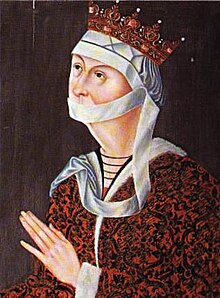
Ernst was founder of the Ernestine line of Saxon princes, and a direct patrilineal ancestor of Prince Albert of Saxe-Coburg and Gotha. He was the second son (but fourth in order of birth) of the eight children of Frederick II, Elector of Saxony and Margaret of Austria, sister of Frederick III, Holy Roman Emperor.

Elisabeth of Bavaria-Munich (2 February 1443 in Munich – 5 March 1484 in Leipzig) was a princess of Bavaria-Munich by birth and by marriage Electress of Saxony.
Elizabeth was a daughter of the Duke Albert the Pious of Bavaria-Munich (1401–1460) from his marriage to Anna of Brunswick-Grubenhagen-Einbeck (1420–1474), daughter of the Duke Eric I of Brunswick-Grubenhagen.
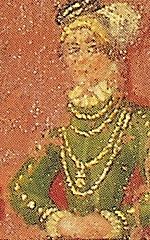
William (German: Wilhelm) called William the Younger (German: Wilhelm der Jüngere, c. 1425 – 7 July 1503) was duke ofBrunswick-Lüneburg and ruled over the Wolfenbüttel and Göttingen principalities.
The eldest son of William the Victorious, Duke of Brunswick-Lüneburg, Cecilia of Brandenburg
Eric II or Erich II (between 1418 and 1425 – 5 July 1474) was a member of the House of Pomerania (also known as the House of Griffins) and was the ruling Duke of Duke of Pomerania-Wolgast from 1457 to 1474. He was the son of Wartislaw IX of Pomerania-Wolgast and Sophia, daughter of Eric IV of Saxe-Lauenburg.

Sophia of Pomerania-Stolp (1435 – 24 August 1497), was a Duchess of Pomerania by birth, and married to Eric II, Duke of Pomerania.
Sophia was the daughter of Bogislaw IX, Duke of Pomerania and Maria of Masovia.
Eitel Friedrich III, Count of Hohenzollern (1494 – 15 January 1525 in Pavia) was Count of County of Hohenzollern from 1512 until his death.
Eitel Friedrich was a son of Count Eitel Friedrich II (1452–1512) from his marriage to Magdalena (1460 -1496), the daughter of Margrave Friedrich of Altmark. Eitel Friedrich succeeded his father as Count of Hohenzollern in 1512.
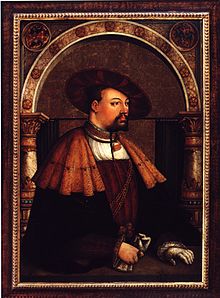
Margrave Ernest I of Baden-Durlach (7 October 1482, Pforzheim – 6 February 1553, Sulzburg) was the founder of the so-called "Ernestine" line of the House of Baden, the line from which the later Grand Dukes descended. He was the ruling Margrave of Baden-Pforzheim from 1533 and resided in Pforzheim from 1537. In 1565, he moved the capital to Durlach and thereby changed to name of his country to Baden-Durlach. He had to deal with the upcoming Reformation and the frequent Ottoman wars in Europe. In this turbulent time, he tried to maintain a neutral position between the Protestants and Catholics. He did not participate in theSchmalkaldic War.
Ernest was the seventh son of the Margrave Christopher I of Baden and Ottilie of Katzenelnbogen.
Elizabeth of Brandenburg-Ansbach-Kulmbach (25 March 1494 in Ansbach – 31 May 1518 in Pforzheim) was a princess ofBrandenburg-Ansbach by birth and by marriage Margravine of Baden.
Elizabeth was a daughter of Margrave Frederick "the Elder" of Brandenburg-Ansbach (1460-1536) from his marriage to Sophia of Poland (1464-1512), a daughter of King Casimir IV Jagiellon of Poland. She was a granddaughter of the powerful Elector Albert III Achilles of Brandenburg. They finally succeeded in 1515. Christopher I abdicated and his sons divided the Margraviate.[1] The Margraviate would remain divided until 1771.
Elisabeth died in 1518 and was buried in the Stiftskirche, Stuttgart.
Juan Hurtado de Mendoza y Guzmán, 3rd Lord and 1st Marquis of Cañete[1] (died 1490) was a Spanish nobleman and military leader.
He was the son of Don Diego Hurtado de Mendoza, 1st Lord of Cañete and of his second wife Teresa de Guzmán. He was elevated to Marquis of Cañete in 1490 by the Catholic Monarchs, who did not know that he had died some days before.
Juan Gomes de Silva, 1º conde de Cifuentes Alfonso Tenorio de Silva, señor de Barcience y Guiomar de Meneses y Toledo
Charles Ier de Bade, dit « le Guerrier ou le Belliqueux » ( allemand: Karl I. von Baden), né en 1425, décédé le à Pforzheim, est margrave de Bade de 1453 à 1475.
Fils de Jacques Ier et de Catherine de Lorraine, Charles Ier de Bade épouse le Catherine d'Autriche (1420-1493) (en) (1420-1493), fille d'Ernest Ier d'Autriche.
Hijo Johan Kris Tier (Vasa), nacido alrededor de 1426, murió cuatro junio 1 mil cuatrocientos setenta y siete en RydboholmCastillo, Östra Ryd, hijo Krister Nilsson (Vasa) y Margareta Eriksdotter Krummedige, donde los concejales y caballeros.
Birgitta Gustav Hija (Sture), murió en cuna 1472. Hija de Gustavo Anundsson Sture y Birgitta Stensdotter (Bielke).
Alberto III di Brandeburgo, spesso conosciuto col nome di Alberto Achille (Tangermünde, 9 novembre1414 – Francoforte sull'Oder, 11 marzo 1486), della casata Hohenzollern, fu principe elettore diBrandeburgo e regnò anche sul principato di Ansbach. Ricevette il soprannome di Achilles per le sue riconosciute doti cavalleresche..
Era il terzo figlio maschio di Federico I ed Elisabetta di Baviera-Landshut e nacque a Tangermünde. Dopo aver passato alcuni anni alla corte dell'imperatore Sigismondo di Lussemburgo, prese parte alla guerra contro gli hussiti, e successivamente si distinse assistendo l'imperatoreAlberto II, contro la Polonia.

Anna di Sassonia (Meißen, 7 marzo 1437 – Neustadt an der Aisch, 31 ottobre 1512) è stata una principessa di Sassonia ed elettrice di Brandeburgo.
Era una figlia del principe elettore Federico II di Sassonia, e di sua moglie, Margherita d'Austria, figlia di Ernesto I d'Asburgo.

Guglielmo IV di Brunswick-Lüneburg (1425 – 7 luglio 1503) fu duca di Brunswick-Lüneburg e governò sui principati di Wolfenbüttel e Gottinga.
Figlio di Guglielmo di Brunswick-Lüneburg e di Cecilia di Brandeburgo, ricevette il principato di Gottinga dal padre nel 1473. Nel 1482, alla morte del padre, gli succedette con il fratello Federico nel governo delle parti rimanenti dello stato, fin quanto imprigionò Federico nel 1484 e si proclamò l'unico reggente. Nel 1490 comprò la città di Helmstedtdall'abate di Werden. Nel 1491, Guglielmo consegnò il principato di Wolfenbüttel inclusa Calenberg al figlio, e mantenne solo Gottinga per sé.
Elisabetta, figlia di Bodo VII di Stolberg-Wernigerode
Gioacchino I di Hohenzollern (Cölln, 21 febbraio 1484 – Stendal, 11 luglio 1535) detto il Nestore, fu Principe elettore diBrandeburgo (1499-1535). Egli trasse il proprio soprannome da Nestore, personaggio della mitologia greca.
Figlio maggiore di Giovanni il Cicerone di Brandeburgo, Gioacchino ricevette un'eccellente educazione sotto la direzione di Dietrich von Bülow, Vescovo di Lebus e Cancelliere dell'Università di Francoforte. Egli divenne Elettore alla morte del padre, nel gennaio del1499.

Elisabetta di Danimarca (14 ottobre 1524 – 15 ottobre 1586) fu una principessa danese, figlia maggiore del re Federico I di Danimarca e della sua seconda moglie Sofia di Pomerania. Tramite matrimonio divenne anche duchessa, prima di Meclemburgo-Schwerin e poi di Meclemburgo-Güstrow.

Federico di Ansbach e Bayreuth, conosciuto anche coi nomi di Federico I o Federico V (Ansbach, 8 maggio 1460 – Ansbach, 4 aprile 1536), era figlio maggiore del margravio Alberto III di Brandeburgo e della sua seconda moglie, Anna, figlia di Federico II di Sassonia.
Sofia Jagellone (6 aprile 1464-5 ottobre 1512), figlia del re Casimiro IV di Polonia e di sua moglie Elisabetta d'Asburgo
Alberto IV di Wittelsbach (Monaco di Baviera, 15 dicembre 1447 – Monaco di Baviera, 18 marzo 1508) fu duca di Baviera-Monaco dal 1467 e duca della Baviera riunita dal 1503.
Alberto era figlio di Alberto III di Baviera e di Anna di Brunswick-Grubenhagen-Einbeck. Dopo la morte del fratello maggiore Giovanni IV rinunciò alla carriera ecclesiastica e da Pavia tornò a Monaco. Quando i suoi fratelli Cristoforo e Wolfgang rinunciarono ai loro diritti, Alberto divenne il solo duca, ma venne creato il nuovo Ducato di Baviera-Dachau da quello già esistente di Baviera-Monaco per il proprio fratello, il DucaSigismondo nel 1467. Alla morte di Sigismondo nel 1501, i domini rientrarono a far parte del Ducato di Baviera-Monaco.

Cunegonda d'Austria, arciduchessa d'Austria (Wiener Neustadt, 16 marzo 1465 – Monaco di Baviera, 6 agosto 1520), era la figlia di Federico V d'Asburgo (futuro imperatore Federico III) e della moglie Eleonora d'Aviz.

John II, "The Pious" or "The Babymaker", Duke of Cleves, Count of Mark, (German: Johann II. "der Pious" oder "der Kindermacher", Herzog von Kleve, Graf von Mark) (1458–1521) was a son of John I, Duke of Cleves and Elizabeth of Nevers.

Mathilde of Hesse (4 July 1473 in Blankenstein – 19 February 1505 in Cologne) was the daughter of Henry III, Landgrave of Upper Hesse (1441-1483) and his wife Anna of Katzenelnbogen (1443-1494).
William IV of Jülich-Berg (9 January 1455 – 6 September 1511) was the last ruler of the Duchy of Jülich-Berg.
William was the son of Gerhard VII, Duke of Jülich-Berg and Sophie of Saxe-Lauenburg. When his father died in 1475, William became Duke of Jülich-Berg.
Sibylle of Brandenburg (31 May 1467 in Ansbach – 9 July 1524 in Kaster) was a Princess of Brandenburg by birth and by marriage Duchess of Jülich and Duchess of Berg.
Sibylle was a daughter of Elector Albrecht III Achilles of Brandenburg (1414–1486) from his second marriage to Anna (1436–1512), daughter of the Elector Frederick II of Saxony.
ohn of Saxony (30 June 1468 – 16 August 1532), known as John the Steadfast or John the Constant, was Elector of Saxonyfrom 1525 until 1532. He was a member of the House of Wettin.
Born in Meissen, he was the fifth of the seven children of Ernest, Elector of Saxony and Elisabeth of Bavaria.
John III the Peaceful, Duke of Cleves and Count of Mark (John III, Duke of Cleves; John I, Duke of Jülich-Berg; German:Johann III der Friedfertige, Herzog von Jülich-Kleve-Berg; 10 November 1490 – 6 February 1538/9) was a son of John II, Duke of Cleves and Mathilde of Hesse, daughter of Henry III, Landgrave of Upper Hesse.[1]
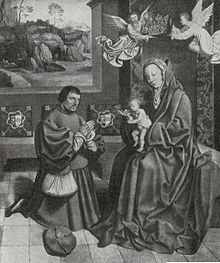
Maria of Jülich-Berg (3 August 1491 – 29 August 1543) was born in Jülich, the daughter of Wilhelm IV, Duke of Jülich-Berg andSibylle of Brandenburg.[1]
Louis II of Zweibrücken (German: Pfalzgraf Ludwig II. von Zweibrücken-Neuburg "der Jüngere") (14 September 1502 – 3 December 1532) was Count Palatine and Duke of Zweibrücken from 1514 to 1532.
He was the son of Alexander, Count Palatine of Zweibrücken and his wife Margarete of Hohenlohe-Neuenstein
Elisabeth of Hesse (4 March 1503 – 4 January 1563, Lauingen) was a Landgravine of Hesse by birth and by marriage Countess Palatine of Zweibrücken and later Countess Palatine of Simmern.
Elizabeth was the youngest of five daughters of Landgrave William I of Hesse (1466–1515) from his marriage to Anna of Brunswick-Wolfenbüttel (1460–1520), daughter of Duke William II of Brunswick-Wolfenbüttel. Elizabeth was raised as a Protestant. In 1518, she was kidnapped by just Landgrave Philip I of Hesse, who had just come of age, to prevent a marriage which her mother Anna had planned, but which Elisabeth herself was opposed to.
Philip I of Hesse, (13 November 1504 – 31 March 1567), nicknamed der Großmütige (the "magnanimous") was a leading champion of the Protestant Reformation and one of the most important of the early Protestant rulers in Germany.
Philip was the son of Landgrave William II of Hesse and his second wife Anna of Mecklenburg-Schwerin

Christine of Saxony (25 December 1505 – 15 April 1549) was a German noble, landgravine of Hesse. She was the regent of Hesse in 1547-1549.
She was the daughter of George, Duke of Saxony "the Bearded", Duke of Saxony and Barbara Jagiellon. Her paternal grandparents were Albert, Duke of Saxony and Sidonie of Bohemia. Her maternal grandparents were Casimir IV Jagiellon, king of Poland andElisabeth of Austria.

Henry (Latin Henricus; 14 June 1463 – 23 June 1514, Leer), Duke of Brunswick-Lüneburg, called Henry the Elder or Henry the Evil, was prince of Wolfenbüttel from 1491 until his death.
Henry's father, William IV, Duke of Brunswick-Lüneburg, retired in 1491, leaving government of Wolfenbüttel to his two sons, Henry the Elder, and Eric. In 1494, the brothers divided the territory between them, and Henry received the eastern part of the state, with the cities of Brunswick and Wolfenbüttel.
Catherine of Pomerania-Wolgast (German: Katherine von Pommern-Wolgast) (c. 1465–1526) was the wife of Henry IV, Duke of Brunswick-Lüneburg, Prince of Wolfenbüttel. She was the daughter of Eric II, Duke of Pomerania-Wolgast, and Sophia of Pomerania-Stolp.
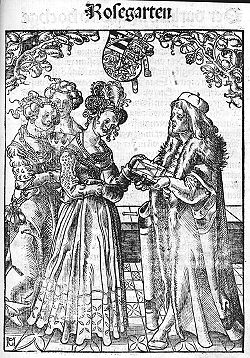
Henry of Württemberg (7 September 1448, Stuttgart – 15 April 1519, Hohenurach Castle near Bad Urach) was from 1473 to 1482Count by Montbéliard.
Henry was the second son of Count Ulrich V of Württemberg-Stuttgart (1413–1480), from his second marriage to Elisabeth of Bavaria-Landshut (1419–1451)

Margrave Ernest I of Baden-Durlach (7 October 1482, Pforzheim – 6 February 1553, Sulzburg) was the founder of the so-called "Ernestine" line of the House of Baden, the line from which the later Grand Dukes descended. He was the ruling Margrave of Baden-Pforzheim from 1533 and resided in Pforzheim from 1537. In 1565, he moved the capital to Durlach and thereby changed to name of his country to Baden-Durlach. He had to deal with the upcoming Reformation and the frequent Ottoman wars in Europe. In this turbulent time, he tried to maintain a neutral position between the Protestants and Catholics. He did not participate in theSchmalkaldic War.
Ernest was the seventh son of the Margrave Christopher I of Baden and Ottilie of Katzenelnbogen.
Ursula of Rosenfeld (c. 1499 – 26 February 1538) was the second wife of Margrave was Ernest of Baden-Durlach. All grand dukes of Baden descend from her, via her son Charles II.
Ursula was born c. 1499 as the youngest child of Wolf of Rosenfeld (d. 1500) and his wife Anna Bombast of Hohenheim. They were considered lower nobility. Her father wasSchultheiß of the town of Rosenfeld in Württemberg.[1]
Louis I of Zweibrücken (German: Pfalzgraf Ludwig I. von Pfalz-Zweibrücken "der Schwarze") (1424 – 19 July 1489) was Count Palatine and Duke of Zweibrücken and of Veldenz in 1444–1489.
He was the younger son of Stefan, Count Palatine of Simmern-Zweibrücken and his wife Anna, heiress of the County of Veldenz, whom he had wed in 1409. Although Anne died in 1439, her widower did not obtain Veldenz from her family until 1444. In that year, Stefan decided how his territories would be divided upon his death, allocating Simmern to his elder son, Frederick and Zweibrucken to his younger son Louis, combining with it Veldenz and most of the County of Sponheim.[1]
Count Kraft VI of Hohenlohe-Weikersheim (1452 in Neuenstein – 2 August 1503 in Neuenstein) was canon (priest) in Mainz andSpeyer.
His parents were Kraft V, Count of Hohenlohe-Weikersheim and Margaret of Oettingen.
Kraft VI married on 26 February 1476 Helene of Württemberg (died: 19 February 1506), daughter of Count Ulrich V of Württembergand Margaret of Savoy.
John IV the Conqueror KG (in Breton Yann IV, in French Jean IV) (1339 – 1 November 1399) was Duke of Brittany and Count of Montfort from 1345 until his death and 7th Earl of Richmond from 1372 until his death.
He was the son of John of Montfort and Joanna of Flanders. His father claimed the title Duke of Brittany, but was largely unable to enforce his claim for more than a brief period. Because his father's claim to the title was disputed, the subject of this article has often been numbered John IV, while his father has been referred to as simply "John of Montfort" (Jean de Montfort). English historians number him as John V, since the English king recognized his father's title. In France he is commonly known as John IV, since the French monarchy, unlike the English, never acknowledged his father's title.
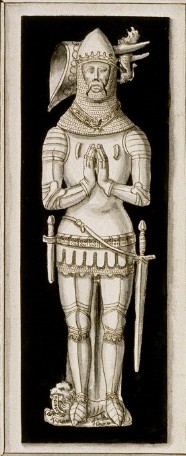
Joanna of Flanders (c. 1295 – September 1374) was Duchess of Brittany by her marriage to John of Montfort. Much of her life was taken up in defence of the rights of her husband and, later, son to the dukedom, which was challenged by the House of Blois during the War of the Breton Succession. Known for her fiery personality, Joanna led the Montfortist cause after her husband had been captured, and began the fight-back, showing considerable skill as a military leader.
In her later life, after the war had entered a stalemate, Joanna became mentally ill. She lived to see the final victory of her cause, but most of her last years she was cared for in England, confined at Tickhill Castle.
Joanna was highly praised by the chronicler Jean Froissart for her courage and energy. Because of her feats of leadership, David Hume described her as "the most extraordinary woman of the age".
Joanna was the daughter of Louis I, Count of Nevers and Joan, Countess of Rethel, and the sister of Louis I, Count of Flanders.

Carlos II de Navarra (Évreux, 10 de octubre de 1332 – Pamplona, 1 de enero de 1387)1 conocido también como Carlos II de Évreux o Carlos el Malo - le Mauvais - fue conde de Évreux - desde el 23 de septiembre de 1343 hasta 1378, momento en que el condado le es incautado por parte de Carlos V - y rey de Navarra - desde el 6 de octubre de 1349 hasta su muerte. Nacido del matrimonio entre Felipe III y Juana II, era por vía materna nieto del rey de Francia, Luis X el Obstinado (1314-6). La exclusión de Juana - única descendiente directa de Luis X - de la sucesión real a causa de la ley sálica2 le cerró las puertas de trono de Francia, que será ocupado por sus tíos Felipe V el Largo (1316 - 1322) y Carlos IV (1322 - 1328), mientras que su tardío nacimiento (1332) le impidió reclamar una corona que a la muerte de Carlos IV (1328) pasará a Felipe de Valois, primo del monarca. No obstante, los primeros Valois reinarán en una etapa marcada por crisis económicas, políticas y sociales, agravadas por el estallido de la Guerra de los Cien Años en la que la superioridad táctica inglesa conducirá a graves derrotas3 que desacreditaron enormemente a la nueva dinastía. Carlos aprovechó el descontento popular para reclamar sus derechos al trono, ambición a la que no renunciará en vida, alimentando de manera constante la inestabilidad de la monarquía.
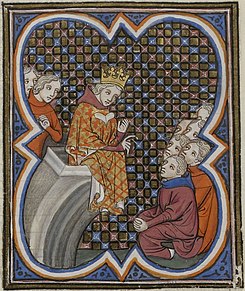
Juana de Valois o Juana de Francia (Châteauneuf-sur-Loire, 24 de junio de 1343 - Évreux, 3 de noviembre de 1373) fue hija de Juan II, rey de Francia, y de su primera esposa, Bona de Luxemburgo.

Carlos V (Vincennes, 21 de enero de 1338 – Nogent-sur-Marne, 16 de septiembre de 1380), llamado el Sabio (en francés, le Sage), fue un monarca de la dinastía Valois, que gobernó como rey de Francia desde 1364 hasta su muerte. Era el hijo primogénito del rey Juan el Bueno y de Bona de Luxemburgo.

Juana de Borbón (* Vincennes (Francia); 3 de febrero de 1338 – † París (Id.); 6 de febrero de 1378) fue la reina consorte de Francia, por su matrimonio con Carlos V de Francia. Hija de Pedro I de Borbón e Isabel de Valois (medio-hermana de Felipe VI de Francia por ser la hija de Carlos de Valois y su tercera mujer Mahaut de Châtillon-Saint Pol).
Su padre, abuelo y hermano sufrían de inestabilidad mental y Juana pareció haber heredado esta enfermedad familia. Sufrió un colapso nervioso total luego del nacimiento de su séptimo hijo. Su hijo mayor (que sobrevivió) era famoso por su locura

Esteban III de Baviera (en alemán, Stephan III der Kneißl, Herzog von Bayern ; 1337 - 26 de septiembre de 1413 enNiederschönenfeld ), fue duque de Baviera desde 1375. Era el hijo mayor de Esteban II de Baviera y de Isabel de Sicilia.
Tadea Visconti, duquesa de Baviera (en italiano, Taddea Visconti; 1351 – 28 de septiembre de 1381) fue una noble italiana de la familia Visconti, la casa gobernante en Milán desde 1277 hasta 1447. Fue la primera esposa de Esteban III, duque de Baviera, y madre de la reina de Francia Isabel de Baviera.1
Nacida en Milán en el año 1351, en algún momento posterior al 27 de junio, Tadea era la hija mayor de Bernabé Visconti, señor de Milán, y Beatriz Regina de la Scala (1331–18 de junio de 1384).2 Tuvo 16 hermanos menores. Sus abuelos paternos fueronStefano Visconti, señor de Milán, y Valentina Doria, y sus abuelos maternos fueron Mastino II de la Scala y Tadea da Carrara.

Roberto II, llamado Roberto Estuardo (Stewart, que significa 'el Senescal' o 'el Administrador', un título que dio el nombre a la Casa de Estuardo). (2 de marzo de 1316 - 19 de abril de 1390) fue rey de Escocia desde 1371 hasta su muerte en 1390, momento en el que le sucedió su hijo Juan, con el nombre de Roberto III.
Roberto era el único hijo de Walter Estuardo, el VI Gran senescal de Escocia y de Marjorie Bruce, hija del rey Roberto I Bruce y de su primera esposa Isabella de Mar. Nació por cesárea. Su madre sobrevivió sólo pocas horas a su nacimiento.1

John of Gaunt, 1st Duke of Lancaster, KG (6 March 1340 – 3 February 1399) was a member of the House of Plantagenet, the third surviving son of King Edward III of England and Philippa of Hainault. He was called "John of Gaunt" because he was born inGhent, then rendered in English as Gaunt. When he became unpopular later in life, scurrilous rumours and lampoons circulated that he was actually the son of a Ghent butcher, perhaps because Edward III was not present at the birth. This story always drove him to fury.[2]
Katherine Swynford, Duchess of Lancaster (also spelled Katharine or Catherine[2]), was the third wife of John of Gaunt, Duke of Lancaster, a son of King Edward III. She had been the Duke's lover for many years before their marriage. The couple's children, born before the marriage, were later legitimated during the reign of the Duke's nephew, Richard II, although with the provision that neither they nor their descendants could ever claim the throne of England.
Their descendants were members of the Beaufort family, which played a major role in the Wars of the Roses. Henry VII, who became King of England in 1485, derived his claim to the throne from his mother Margaret Beaufort, who was a great-granddaughter of Gaunt and Katherine Swynford. His legal claim to the throne, however, was through a matrilineal and previously illegitimate line and Henry's first action was to declare himself king "by right of conquest" retroactively from 21 August 1485, the day before his army defeated King Richard III at the Battle of Bosworth.[3]
Katherine was the daughter of Paon de Roet, a herald, and later knight, who was "probably christened as Gilles".[4] She had two sisters, Philippa and Isabel (also called Elizabeth) de Roet, and a brother, Walter. Isabel later became Canoness of the convent of St. Waudru's, Mons, c. 1366. Katherine is generally held to have been his youngest child. However, Alison Weir argues that Philippa was the junior and that both were children of a second marriage.[4] Katherine's sister Philippa, a lady of Queen Philippa's household, married the poet Geoffrey Chaucer.
Thomas Holland (also known as de Holland),[1] 2nd Earl of Kent, 3rd Baron Holand KG (1350/1354 – 25 April 1397) was anEnglish nobleman and a councillor of his half-brother, King Richard II of England.
Thomas Holland (or de Holand)[1] was born in Upholand, Lancashire, in 1350[1][3] or 1354[2][4] (sources differ on his birth year). He was the eldest surviving son of Thomas Holland, 1st Earl of Kent, and Joan "The Fair Maid of Kent".[5] His mother was a daughter ofEdmund of Woodstock, 1st Earl of Kent, and Margaret Wake. Edmund was in turn a son of Edward I of England and his secondQueen consort Marguerite of France, and thus a younger half-brother of Edward II of England.
His father died in 1360, and later that year, on 28 December, Thomas became Baron Holand.[3] His mother was still Countess of Kent in her own right, and in 1361 she married Edward, the Black Prince, the son of King Edward III.
His father died in 1360, and later that year, on 28 December, Thomas became Baron Holand.[3] His mother was still Countess of Kent in her own right, and in 1361 she married Edward, the Black Prince, the son of King Edward III.
Alice Holland, Countess of Kent (c. 1350[1] – 17 March 1416), LG, formerly Lady Alice FitzAlan, was an English noblewoman, a daughter of the 10th Earl of Arundel, and the wife of the 2nd Earl of Kent, the half-brother of King Richard II. As the maternal grandmother of Anne Mortimer, she was an ancestor of King Edward IV and King Richard III, as well as King Henry VII and theTudor dynasty through her daughter Margaret Holland. She was also the maternal grandmother of Joan Beaufort, Queen of Scotland.
She was appointed a Lady of the Garter in 1388.
Lady Alice FitzAlan was born circa 1350 at Arundel Castle in Sussex, England,[2] the second daughter of the 10th Earl of Arundel, and Lady Eleanor of Lancaster. She had six siblings who included Richard FitzAlan, later 11th Earl of Arundel, and Lady Joan FitzAlan, later Countess of Hereford, Essex, and Northampton. She also had three half-siblings from her parents' previous marriages.
Her paternal grandparents were the 9th Earl of Arundel and Alice de Warenne, and her maternal grandparents were the 3rd Earl of Lancaster and Maud Chaworth.
Frederick II (Friedrich, der Sanftmütige; Frederick the Gentle) (Leipzig, 22 August 1412 – 7 September 1464 in Leipzig) was Elector of Saxony (1428–1464) and was Landgrave of Thuringia (1440–1445).
Frederick was the eldest of the seven children of Frederick I, Elector of Saxony, and Catherine of Brunswick and Lunenburg.


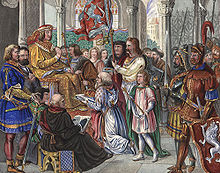
He was the son of Adolph I, Duke of Cleves and Mary of Burgundy. He was raised in Brussels at the Burgundian court of his unclePhilip the Good He ruled Cleves from 1448 from 1481, and Mark since 1461 after the death of his uncle Gerhard, who had waged war on his own brother.


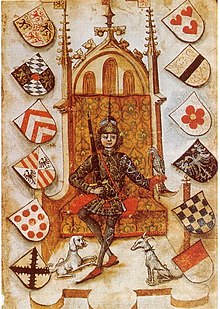



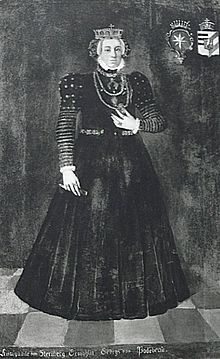

Frederick II (Friedrich, der Sanftmütige; Frederick the Gentle) (Leipzig, 22 August 1412 – 7 September 1464 in Leipzig) was Elector of Saxony (1428–1464) and was Landgrave of Thuringia (1440–1445).
Frederick was the eldest of the seven children of Frederick I, Elector of Saxony, and Catherine of Brunswick and Lunenburg.

Margaret of Austria (c. 1416 – 12 February 1486) was the elder daughter of Ernest, Duke of Austria and his second wife Cymburgis of Masovia. From her marriage she was Electress of Saxony. She was sister of Frederick III, Holy Roman Emperor.
Margaret was betrothed to Frederick II, Elector of Saxony [1] in 1428, not long after his accession; the wedding took place on 3 June 1431 at Leipzig. She reconciled her husband with his brother, William III, Landgrave of Thuringia and also took part in the otherwise intense government. Margaret received her own coinage.

Albert III the Pious of Bavaria-Munich (German: Albrecht III. der Fromme, Herzog von Bayern-München; 27 March 1401 – 29 February 1460), since 1438 Duke of Bavaria-Munich. He was born in Munich to Ernest, Duke of Bavaria and Elisabetta Visconti, daughter of Bernabò Visconti.
He was first engaged in 1429, to Elisabeth, the daughter of Eberhard III, Count of Württemberg, but she eloped and married a Count of Werdenberg, who had been a page at her father's court.

Anna of Brunswick-Grubenhagen-Einbeck (1414 – 4 April 1474) was a daughter of Duke Eric I of Brunswick-Grubenhagen and his wife, Elisabeth of Brunswick-Göttingen.
John I, Duke of Cleves, Count of Mark (16 February 1419 – 5 September 1481) was Duke of Cleves and Count of Mark.

Elizabeth of Nevers (born: after 24 August 1439 in Nevers; died: 21 June 1483)[1] was Duchess of Cleves from 1455 until her death, due to her marriage with John I of Cleves-Mark. She is the matriarch of the house of Cleves-Nevers, and thus the Cleves line of the Counts and dukes of Nevers. Because the territory was part of her inheritance, it fell to her son Engelbert after her death.
Elizabeth was the oldest child of John II, Count of Étampes, Nevers, Rethel and Eu, and his first wife Jacqueline d'Ailly. Since Elizabeth's younger brother died at the age of five years and her father thus had no sons, he appointed his eldest daughter to the heir of the counties of Nevers and Eu.

Henry III, Landgrave of Upper Hesse, called "the Rich" (15 October 1440[1] – 13 January 1483) was the second son of Louis I of Hesse and his wife Anna of Saxony.
Anna, daughter and heir of Philipp, the last Count of Katzenelnbogen and his wife Anne of Württemberg.
Gerhard VII, Duke of Jülich-Berg (c. 1416 – 19 August 1475) was the son of William VIII of Jülich, Count of Ravensberg and Adelheid of Tecklenburg. Gerhard was the second duke of the combined Duchy of Jülich-Berg but the 7th Gerhard in the House of Jülich.[1]

Sophie of Saxe-Lauenburg (born: before 1444; died: 9 September 1473) was a Duchess of Saxe-Lauenburg by birth and by marriage Duchess of Jülich-Berg. From 1456 until her death, she was regent of Jülich, Berg and Ravensberg for her eldest son.
Sophie was the daughter of Duke Bernard II of Saxe-Lauenburg († 1463) from his marriage to Adelheid (who died after 1445), a daughter the Duke Bogislaw VIII of Pomerania.
in 1444,
Albert III (German: Albrecht III.) (9 November 1414 – 11 March 1486), often known simply as Albert Achilles (Albrecht Achilles), was a Prince-elector of the Margraviate of Brandenburg. He received the nickname Achilles because of his knightly qualities. He also ruled the Principality of Ansbach.
Albert was born in Tangermünde as the third son of Elector Frederick I and his wife, Elisabeth of Bavaria-Landshut. After passing some time at the court of Emperor Sigismund, Albert took part in the war against the Hussites, and afterwards distinguished himself whilst assisting the German king, Albert II, against Poland.[1]

Anna of Saxony (7 March 1437 – 31 October 1512) was a princess of Saxony by birth and Electress of Brandenburg by marriage.
Anna was a daughter of the Elector Frederick II of Saxony from his marriage to Margaret of Austria, daughter of the Duke Ernest of Austria.

Frederick I, the Hunsrücker (German: Friedrich I.) (19 November 1417 – 29 November 1480) was the Count Palatine of Simmernfrom 1459 until 1480.
Frederick was born in 1417 to Stephen, Count Palatine of Simmern and Zweibrücken and his wife, Anna of Veldenz. In 1444 his father partitioned his territories between Frederick and his younger brother Louis. Frederick married Margaret of Guelders, daughter of Duke Arnold, on 16 August 1454. Frederick died in Simmern in 1480 and was buried in the Augustinian Abbey of Ravengiersburg.
Charles I of Baden (1427 – 24 February 1475, Pforzheim) was a Margrave of Baden-Baden during 1454–1475.
Charles was the elder son of Jacob, Margrave of Baden-Baden and his wife Catherine, daughter of Charles II, Duke of Lorraine. In 1462 he became involved in the Bavarian War (1459–63) against Frederick I, Elector Palatine. This war finished in the same year with Charles' defeat and capture at the Battle of Seckenheim.
Catherine of Austria (1424 in Wiener Neustadt – 11 September 1493 at Hohenbaden Castle in Baden-Baden) was a member of the House of Habsburg and through marriage Margravine of Baden.
Catherine was a daughter of the Duke Ernest I of Austria and Styria, nicknamed "the Iron" (1377-1424) from his marriage toCymburgis (1394-1429), a daughter of Duke Siemowit IV of Masovia. Catherine's older brother Frederick III was crowned Holy Roman Emperor in 1452. She grew up in Wiener Neustadt, together with her brothers Frederick III and Albert VI.[1]
Philipp I of Katzenelnbogen (1402–1479), also known "Philipp the Elder" was Count of Katzenelnbogen from 1444 to 1479 and was the last male descendant of the Counts of Katzenelnbogen (his two sons died before him). His parents were Johann IV, Count of Katzenelnbogen (younger line) and Anne of Katzenelnbogen (older line), who merged the two lines of the family back together in 1402.
George of Kunštát and Poděbrady (23 April 1420 – 22 March 1471), also known as Poděbrad or Podiebrad (Czech: Jiří z Poděbrad; German: Georg von Podiebrad), was King of Bohemia (1458–1471). He was leader of the Hussites.
George was the son of Victor of Kunštát and Poděbrady, a Bohemian nobleman, one of the leaders of the Orphans or Utraquists, the more moderate faction of the Hussites during the Hussite Wars. At the age of fourteen, George himself took part in the Battle of Lipany, which marked the downfall of the more radical Taborites.

Kunigunde of Sternberg (Czech: Kunhuta ze Šternberka; 18 November 1425, Konopiště – 19 November 1449, Poděbrady) was the first wife of George of Poděbrady, who later became King of Bohemia. Kunigunde's parents were the Bohemian nobles Smil of Sternberg († 1431) and Barbara of Pardubice († 1433). In 1441 she married then 21-year-old George of Poděbrady, who had been captain of the old Bohemian circle of Stará Boleslav[1] since 1440.

Albert III (German: Albrecht III.) (9 November 1414 – 11 March 1486), often known simply as Albert Achilles (Albrecht Achilles), was a Prince-elector of the Margraviate of Brandenburg. He received the nickname Achilles because of his knightly qualities. He also ruled the Principality of Ansbach.
Albert was born in Tangermünde as the third son of Elector Frederick I and his wife, Elisabeth of Bavaria-Landshut. After passing some time at the court of Emperor Sigismund, Albert took part in the war against the Hussites, and afterwards distinguished himself whilst assisting the German king, Albert II, against Poland.[1]

Margaret of Baden (1431 – 24 October 1457) was a Margravine of Baden by birth and by marriage Margravine of Brandenburg-Ansbach and Brandenburg-Kulmbach. She was the daughter of Jacob, Margrave of Baden-Baden, and his wife Catherine of Lorraine.
Alexander of Zweibrücken (German: Pfalzgraf Alexander von Zweibrücken "der Hinkende") (26 November 1462 – 21 October 1514) was Count Palatine and Duke of Zweibrücken and of Veldenz in 1489–1514.
He was the son of Louis I, Count Palatine of Zweibrücken and his wife Johanna of Croÿ. Alexander promised to establish a church after the successful return from a crusade, and it was kept in 1489 with the building of the Alexanderskirche in Zweibrücken.
Countess Margarete of Hohenlohe-Neuenstein, daughter of Count Kraft VI of Hohenloheand Helene of Württemberg.
William I of Hesse (German: Wilhelm) (4 July 1466 – 8 February 1515) was the Landgrave of Hesse (Lower Hesse) from 1471 to 1493.
His parents were Louis the Frank (1438–1471) and Mechthild, daughter of Count Louis I of Württemberg. On 17 February 1488 inMünden,
Anna of Brunswick-Wolfenbüttel c. 1460 - Worms 16 May 1520], daughter of William II, Duke of Brunswick-Wolfenbüttel and Elisabeth, Countess of Stolberg,
Hedwig of Cieszyn (Polish: Jadwiga cieszyńska, Hungarian: Hedvig tescheni hercegnő) (1469 – 6 April 1521) was a Polishprincess and member of the House of Piast in the Cieszyn branch.
She was the only child of Przemysław II, Duke of Cieszyn by his wife Anna, daughter of Duke Bolesław IV of Warsaw.

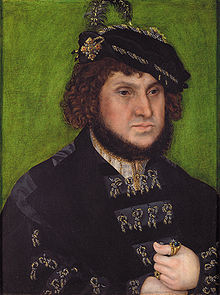

No hay comentarios:
Publicar un comentario